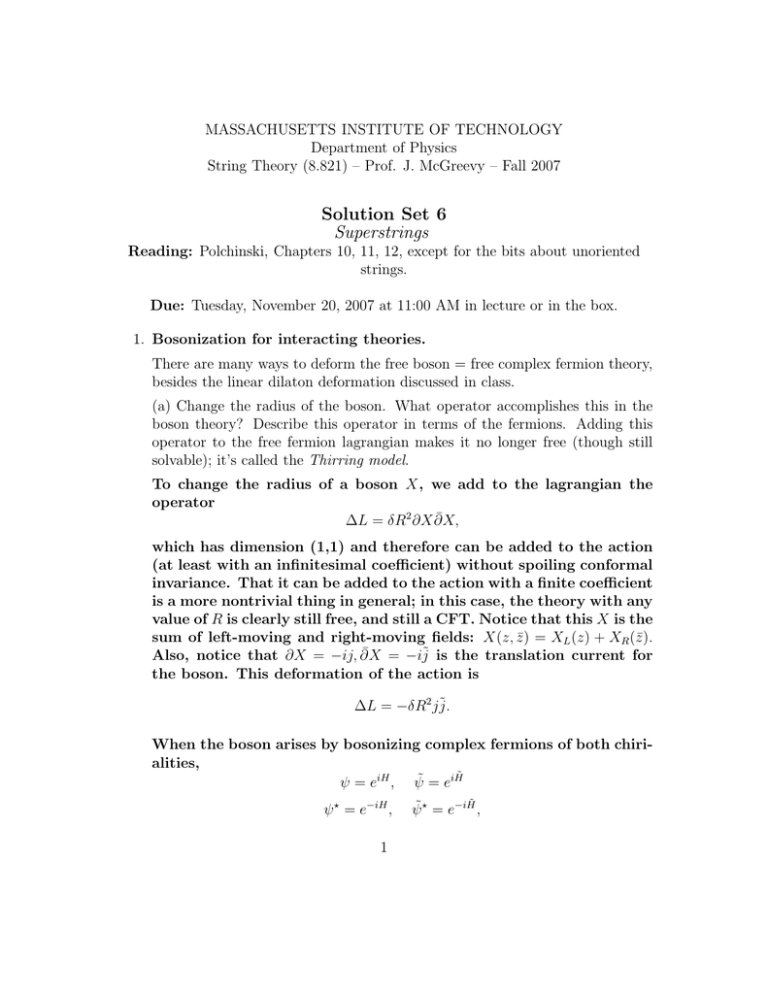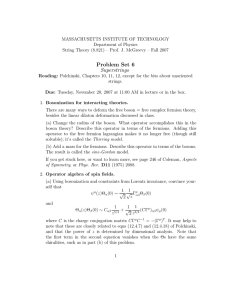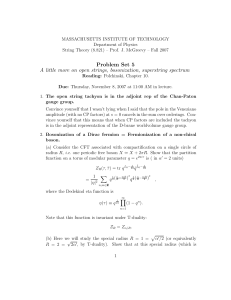MASSACHUSETTS INSTITUTE OF TECHNOLOGY Department of Physics
advertisement

MASSACHUSETTS INSTITUTE OF TECHNOLOGY
Department of Physics
String Theory (8.821) – Prof. J. McGreevy – Fall 2007
Solution Set 6
Superstrings
Reading: Polchinski, Chapters 10, 11, 12, except for the bits about unoriented
strings.
Due: Tuesday, November 20, 2007 at 11:00 AM in lecture or in the box.
1. Bosonization for interacting theories.
There are many ways to deform the free boson = free complex fermion theory,
besides the linear dilaton deformation discussed in class.
(a) Change the radius of the boson. What operator accomplishes this in the
boson theory? Describe this operator in terms of the fermions. Adding this
operator to the free fermion lagrangian makes it no longer free (though still
solvable); it’s called the Thirring model.
To change the radius of a boson X, we add to the lagrangian the
operator
¯
∆L = δR2 ∂X ∂X,
which has dimension (1,1) and therefore can be added to the action
(at least with an infinitesimal coefficient) without spoiling conformal
invariance. That it can be added to the action with a finite coefficient
is a more nontrivial thing in general; in this case, the theory with any
value of R is clearly still free, and still a CFT. Notice that this X is the
sum of left-moving and right-moving fields: X(z, z̄) = XL (z) + XR (z̄).
¯ = −ij̃ is the translation current for
Also, notice that ∂X = −ij, ∂X
the boson. This deformation of the action is
∆L = −δR2 j j̃.
When the boson arises by bosonizing complex fermions of both chirialities,
ψ = eiH , ψ̃ = eiH̃
ψ ⋆ = e−iH ,
1
ψ̃ ⋆ = e−iH̃ ,
and there are again left-moving and right-moving currents:
j = ψ ⋆ ψ,
j̃ = ψ̃ ⋆ ψ̃,
which map to the momentum currents above. In terms of the fermions,
the deformation is therefore
∆L = −δR2 j j̃ = −δR2 ψ ⋆ ψ ψ̃ ⋆ ψ̃,
a four-fermion interaction.
(b) Add a mass for the fermions. Describe this operator in terms of the bosons.
The result is called the sine-Gordon model.
If you get stuck here, or want to learn more, see page 246 of Coleman, Aspects
of Symmetry, or Phys. Rev. D11 (1975) 2088.
The mass term for the fermions is something like
∆L = −m(ψ ψ̃ + ψ ⋆ ψ̃ ⋆ )
(where I’ve chosen to break the vectorlike fermion number ψ →
αψ, ψ̃ → αψ̃ and preserve the axial fermion number ψ → βψ, ψ̃ →
β −1 ψ̃). In terms of bosons, this is
∆L = −m eiH eiH̃ + e−iH e−iH̃
since H, H̃ have no OPE singularity, this is
∆L = −m ei(H+H̃ ) + e−i(H+H̃ ) = −2m cos H(z, z̄),
a sine-gordon interaction.
A few comments:
(i) If we had chosen the mass term to break the axial current instead,
this would have been a condensate of a winding mode,
cos Ĥ,
Ĥ(z, z̄) ≡ H(z) − H̃(z̄).
(ii) This operator cos H, unlike the change-of-radius operator is not
dimension (1,1), at least in the absence of the four-fermion term. It
is a relevant operator which drives an RG flow towards a mass gap.
2
The fact that the dimension of the cosine depends on the radius of the
boson (and in particular can vary from irrelevant to relevant) is the
origin of the Kosterlitz-Thouless phase transition of the XY model
in two spatial dimensions (see e.g. Chaikin and Lubensky Principles of
Condensed Matter Physics, §9.2)
2. Operator algebra of spin fields.
(a) Using bosonization and constraints from Lorentz invariance, convince yourself that
1 1
ψ µ (z)Θα (0) ∼ √ √ Γµαβ Θβ (0)
2 z
and
Θα (z)Θβ (0) ∼ Cαβ
1
z 5/4
1 1
+ √ 3/4 (CΓµ )αβ ψµ (0)
2z
where C is the charge conjugation matrix CΓµ C −1 = −(Γµ )T . It may help to
note that these are closely related to eqns (12.4.7) and (12.4.18) of Polchinski,
and that the power of z is determined by dimensional analysis. Note that
the first term in the second equation vanishes when the Θs have the same
chiralities, such as in part (b) of this problem.
If you want to worry about signs and factors, it might be helpful to come to
terms with the equations of p. 77 of Peskin’s notes, where he gives an explicit
prescription for the cocyles for the spin fields.
First, bosonize:
1
a
√ ψ 2a ± iψ 2a+1 = e±iH ,
2
1
0
√ ±ψ 0 + iψ 1 = e±iH
2
Θα = eiαa H
a
where αa = ± 12 . H is a free boson so
: eiα·H : (z) : eiβ·H : (0) = z α·β ei(α+β)·H(0) + ...
where note that I’m using as indices the weight vectors α (sometimes
called s).
The fusion of the spinor and the vector gives
e±iH
a (z)
Θα (0) ∼ z αa ei(αb +eb )H
3
b
where eb is a vector of zeros with a 1 in the bth entry. If αa = − 12 , this
is singular, and in that case αa + ea = + 21 ; the spin has been flipped.
If αa = + 12 , this OPE is nonsingular. Therefore, the singular part
of the OPE is exactly the action of the Γ matrices in the creationannihilation basis we contructed (see Appx B of Polchinski)
Γ0± =
and we find
1
±Γ0 + Γ1 ,
2
Γa± =
1
±Γ2a ± iΓ2a+1
2
√
1 1
ψ µ (z)Θα (0) ∼ √ √ Γµαβ Θβ (0) + O( z)
2 z
a
b
Θα (z)Θβ (0) = eiαa H (z)eiβb H (0).
∼ z αa βa ei(αa +βa )H
a (0)
+ ...
Only if αa = −βa for a given a – i.e. if the spins along that plane differ
– does a given Ha make a singular
P contribution to the OPE. The possible values of the exponent a αa βa are −5/4, −3/4, −1/4, 1/4, 3/4, 5/4
depending on how many components of α and β differ. If we allow
the Θs to have different chirality (i.e. different parity of the number
of up spins), then all five can be different, which gives a term going
like
z 5/4 Cαβ
– Cαβ is the matrix in the spin space which is only nonzero if all the
components of α and of β are different.
If α and β have the same chirality, the most singular bit comes from
flipping four out of five spins. The power of z from this is
3
1 1 1 1 1
− − − − + =− .
4 4 4 4 4
4
This leaves a single component of α and β the same, and that entry
(say αb = βb ) will add instead of cancelling in αa + βa , this entry will
add up to:
αb + βb = 2βb = ±1
which gives
ei
P
a (αa +βa )H
a
= ei2αb H
4
b
(no sum on b).
The object on the RHS here is exactly
1
b
ei2αb H = √ ψ 2b ± iψ 2b+1
2
(where we make an exception when b = 0 to allow for the existence
of time (whose idea was that?)). Since the Lorentz-covariant object
which intertwines between the vector and spinor representations is
exactly a gamma matrix, we have
Θα (z)Θβ (0) ∼ Cαβ
1
z 5/4
1 1
1
+ √ 3/4 (CΓµ )αβ ψµ (0) + 1/4 Cαβ + regular
z
2z
where Cαβ is a matrix which only has nonzero elements if α and β
differ by three spins, and I suppose has two fermions in it – again,
the first and third terms are zero if the Θs have the same chirality,
which they always will in a sensible CFT, exactly because these terms
would prevent a local OPE between Θs of opposite chirality. This
is yet another point where we are saved from dragons by the GSO
projection.
(b) Verify the algebra of spacetime supersymmetry generators
I
I
dz −φ/2
dz
Vα (z) =
e
Θα (z).
Qα =
2πi
2πi
By the usual contour argument, using the mysterious fact that Vα Vβ =
−Vβ Vα , we have
I
I
dz
dw
{Qα , Qβ } =
Vα (w)Vβ (z)
C0 2πi Cz 2πi
where Cz is a contour centered on z. The VV OPE, which is the ΘΘ
OPE in part a (for Θs of the same chirality) times
: e−φ(w)/2 :: e−φ(z)/2 :∼
1
: e−φ(z) : +...
(w − z)1/4
gives
{Qα , Qβ } =
I
C0
dz
2πi
I
Cz
dw 1
1
√
e−φ(z) (CΓµ )αβ ψµ (z) + ...
2πi 2 w − z
5
=
I
C0
dz 1 −φ(z)
√ e
(CΓµ )αβ ψµ (z).
2πi 2
This is the momentum generator in a different picture, i.e. an object
which when you act on it with a picture changing operator (which will
always be available in an amplitude where you have an opportunity
to use this algebra, Hand the answer is independent of where we put
the PCOs) you get ∂X. This is true because
r
2
1
i
∂Xµ (z)
P+1 e−φ ψµ (z) = lim
eφ TF (z ′ )e−φ ψµ (z) = lim
(z ′ − z) ′
′
′
z →z
z →z
z −z
α′
The momentum of the (left-moving bit of the) closed string is
I
dz
1
µ
∂X µ
p = ′
α
2π
which gives
r
2
1
dz
µ
µ
i
∂X
=
√
′ (CΓ )αβ pµ .
′
2πi
α
α
C0
√
I don’t have anything useful to say about the α′ .
1
P+1 {Qα , Qβ } = √ (CΓµ )αβ
2
I
3. A little more superstring scattering.
Polchinski, problem 12.8.
This problem asks us to study the tree-level scattering of three closed
superstring bosons, two RR and one NSNS. The amplitude, with
pictures chosen to saturate the sphere ghost anomaly of −2 on left
and right, is
D
E
(− 21 ,− 21 )
(− 12 ,− 21 )
(3)
(−1,−1)
AS 2 = cc̃V1
(z1 )cc̃V2
(z2 )cc̃V3
(z3 )
S2
where the vertex operators are
1
1
V (− 2 ,− 2 ) (z) = gc e−φ/2−φ̃/2 Θα Θ̃β eik·X F αβ
and
1
1
V (− 2 ,− 2 ) (z) = gc e−φ−φ̃ ψ µ ψ̃ ν eik·X ζµν .
6
The correlators we need are
hcc̃(z1 )cc̃(z2 )cc̃(z3 )iS 2 = CSgh2 |z12 z23 z31 |2
−1/2
|z13 z23 |−1 .
he−φ/2−φ̃/2 (z1 )e−φ/2−φ̃/2 (z2 )e−φ−φ̃ (z3 )iS 2 = CSsgh
2 |z12 |
h
3
Y
: eiki ·X :iS 2 = CSX2
i=1
Y
i<j
′
|zij |α ki ·kj δ̃ 10 (
X
−3/4 −1/2 −1/2 1
z23 √
hΘα (z1 )Θγ (z2 )ψ µ (z3 )iS 2 = z12 z13
2
k).
(CΓµ )αγ
and similarly for the tilded objects with z → z̄.
This gives
(3)
AS 2 = CS 2 δ̃ 10
X Y
′
|zij |α ki ·kj
k F1αβ F2γδ ζµν (CΓµ )αγ (CΓν )βδ |z12 |−1/2−3/2+2 |z23 |−1−1+2 |z31 |−1−1+2
i<j
where I’ve lumped all the path integral normalizations into one along
with the vertex normalizations and the dilaton-dependence; applying
2
the
Poptical theorem relates these to the string coupling. Using k1 =
0, k = 0, we see that ki · kj = 0, so the z-dependence dies as it must.
We get
X (3)
k F1αβ F2γδ ζµν (CΓµ )αγ (CΓν )βδ .
AS 2 = CS 2 δ̃ 10
4. The bosonic tachyon and the superstring.
The bosonic string tachyon, whose vertex operator is eik·X , is not a physical
state of the superstring because it isn’t supersymmetric, i.e. it is not killed
by the TF part of the BRST operator. However, a skeptic might worry that it
would somehow try to appear in interactions of allowed states (even though the
BRST construction guarantees that it does not). In fact, it comes dangerously
close to appearing, as follows. 1
Consider the OPE of two (-2)-picture NS tachyons (ignore the contribution of
the superconformal ghosts here, which gives an extra factor of e−2φ ):
(−2)
Vk
1
≡ ik · ψeik·X .
This problem follows some comments in section 9.13 of Polyakov’s book.
7
Show that it contains pole terms that look very much like the bosonic tachyon
vertex eik·X . Become afraid. Then show that the coefficient of this term vanishes when the on-shell condition for the superstring tachyon is imposed.
(−2)
(−2)
(z)Vk2 (0) =: ik1 · ψ(z)eik1 ·X(z) :: ik2 · ψ(0)eik2 ·X(0) :
δµν
′
µ ν
+ z : ψ∂ψ : +... z α k1 ·k2 : eik1 ·X(z)+ik2 ·X(0) :
∼ −k1 k2
z
Vk 1
∼ −k1 · k2
1
z 1+α′ k1 ·k2
: ei(k1 +k2 )·X(0) : (1 + O(z))
which looks dangerously like we’ve produced the bosonic tachyon,
which could go on shell if its momentum p = k1 + k2 satisfied
α′ p2 = 2.
(Irma)
But now we must realize that the tachyons are on-shell:
α′ ki2 = 1, i = 1, 2
which using (Irma) implies
2k1 · k2 = (k1 + k2 )2 − k12 − k12 = 2 − 1 − 1 = 0,
and so the residue of the would-be on-shell bosonic tachyon pole is
zero. Thank goodness.
The following problems don’t actually require a written response:
5. Anomalies. Read Polchinski section 12.2 about anomalies in type I supergravity, and their cancellation using the Green-Schwarz mechanism. Look at
section 12.6 where JP shows that for the heterotic string the required B ∧tr F 4
term is generated at one loop.
6. The oracle speaks on GSO.
Try to understand the following statements in favor of the GSO projection,
from Polyakov’s book (p. 251). “...only under the above prescription [i.e. only
when making the GSO projection and summing over R and NS sectors] is it
possible to treat the system in terms of spin operators [i.e. is it equivalent to
8
an Ising model]. For that matter, take an Ising model on a surface with high
genus. We know that usually [i.e. on the plane] this model can be replaced
by free fermions. Is this still true? In fermionization of Ising spins a crucial
role is played by Kramers-Wannier duality... Fermionic lines are essentially
the boundaries of drops containing reversed spins. However, if the surface
is homologically nontrivial [i.e. genus > 0], there are closed paths which do
not form boundaries of anything. We must ensure that fermionic trajectories
corresponding to these paths do not contribute. The way to achieve this is just
to sum over spin structures, since then each homologically nontrivial path will
be cancelled by one of the opposite spin structure.”
7. Geometry.
Soon we are going to start using some fancy geometry. Start looking at section
2 of hep-th/9702155.
9





